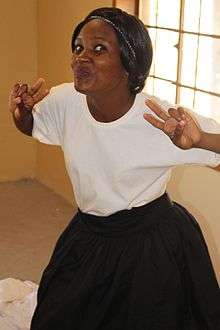Kalanga people
The Bakalanga, or Kalanga, are a southern Bantu ethnic group mainly inhabiting Matebeleland in Zimbabwe, northeastern Botswana and Limpopo Province in South Africa. They are historically related to the Nambya, Lozi, Karanga and Venda
 Kalanga woman in Botswana | |
| Total population | |
|---|---|
| 850,000 | |
| Regions with significant populations | |
| 700,000[1] | |
| 150,000[1] | |
| Languages | |
| Ndebele, TjiKalanga, Shona languages | |
| Religion | |
| African Traditional Religion, Christianity | |
| Related ethnic groups | |
| Northern Ndebele, Shona, and other Southern Bantu peoples | |
Language
The native language of the Kalanga people has two varieties: 1) TjiKalanga, or simply Kalanga, in western Zimbabwe, 2) Ikalanga in northeastern Botswana. Together with the Nambya language, these varieties form the western branch of the group (Guthrie S.10) that also includes Central Shona.[2] Kalanga-speakers once numbered over 500,000, though they are now much reduced, often speaking Ndebele or Central Shona languages in Zimbabwe, Tswana in Botswana, and other local languages of the surrounding peoples of southern Africa.[2]
The BaKalanga are one of the largest ethnolinguistic groups in Botswana. The 1946 census indicated that there were 22,777 (40% of the numerically largest district) BaKalanga in the Bamangwato (Central) District.[3]
History
_(14596864227).jpg)
According to Huffman (2008), the original Bakalanga people descended from Leopard's Kopje farmers.[4] These people occupied areas covering parts of north eastern Botswana, western and southern Zimbabwe, adjacent parts of South Africa and Mozambique by around AD 100. They traded in ivory, furs and feathers with the Indian Ocean coast for goods such as glass beads and cotton clothes.[5] The majority of these prehistoric Bakalanga villages have been discovered in Botswana and Zimbabwe in areas close to major rivers and were usually built on terraced hilltops with stone walls built around them.[6]
The Kalanga are linked to such early African States as Mapungubgwe, Khami, and the Rozvi Empire. The early Bakalanga people living in the Shashe-Limpopo basin monopolised trade due to their access to the Indian Ocean coast. By around AD 1220 a new and more powerful kingdom developed around Mapungubgwe Hill, near Botswana’s border with South Africa. Some of the early Bakalanga people living in the lower Shashe-Limpopo valley probably moved towards or became part of this newly formed kingdom. But studies of climatic data from the area suggest that a disastrous drought soon struck Mapungubgwe, and the Shashe-Limpopo region was uninhabited between A.D 1300 and 1420, forcing the ordinary population to scatter. Mapungubgwe had become a ghost town by AD 1290. Its golden era lasted no more than 50 years culminating in the rise of Great Zimbabwe.
Later, in the 15th century, the centre of power moved back west, from Great Zimbabwe to Khami, and in the 17th century to Danangombe (Dlodlo). The moves were accompanied by changes of the dominance from one clan to another. In the 17th century, the Lozvi established southern BaKalanga became a powerful competitor, controlling most of the mining areas. The Lozvi even repelled Portuguese colonists from some of their inland posts.
In south-western Zimbabwe (now Matabeleland) and adjacent parts of present-day Botswana, Kalanga states survived for more than another century. The fall of the Kingdom of Butua came as a result of a series of invasions, beginning with the Bangwato Kgosi Kgari's ill-fated incursion of around 1828 and culminating in the onslaught of Mzilikazi's Amandebele.
Finally, the Zimbabwe plateau and Lowveld as well as Botswana basin were subdued to British rule by Cecil Rhodes.
Bakalanga villages and towns
|
|
|
|
References
- Lewis, M. Paul (2009). "Kalanga 'The cultural people'". Ethnologue. SIL International. Retrieved 25 October 2012.
- "Language". Kalanga. Kalanga Language and Cultural Development Association (KLCDA). Retrieved 18 September 2018.
- This excluded those in the North-east District Mpho, Motsamai Keyecwe (1989). "Representation of cultural minorities in policy making". In Holm, John D.; Molutsi, Patrick P. (eds.). Democracy in Botswana: The Proceedings of a Symposium Held in Gaborone, 1-5 August 1988. Botswana Society Conference publication. Gaborone, Botswana: Macmillan. pp. 130–38. ISBN 978-0-8214-0943-5.
- Huffman, T. N. (2008). "Zhizo and Leopard's Kopje: test excavations at Simamwe and Mtanye, Zimbabwe". In Badenhorst, Shaw; Mitchell, Peter; Driver, Jonathan C. (eds.). Animals and people: Archaeozoological papers in honour of Ina Plug. Oxford, England: Archaeopress. pp. 200–214. ISBN 978-1-4073-0336-9. See also, Huffman, T. N. (1974). The Leopard Kopje Tradition. Doctoral dissertation. University of Illinois at Urbana-Champaign.
- Van Waarden, Catharina (1998). "The Late Iron Age". In Lane, Paul J.; Reid, Andrew; Segobye, Alinah (eds.). Ditswa Mmung: The Archaeology of Botswana. Gaborone, Botswana: Botswana Society. pp. 115–160. ISBN 978-99912-60-39-6.
- Tlou, Thomas; Campbell, Alec (1984). History of Botswana (PDF). Botswana: Macmillan Botswana Publishing Co (Pty) Ltd. ISBN 0333-36531-3.
Further reading
- David N. Beach: The Shona and Zimbabwe 900–1850. Heinemann, London 1980 und Mambo Press, Gwelo 1980, ISBN 0-435-94505-X
- Catharina Van Waarden: Butua and the end of an era: The effect of the collapse of the Kalanga State on ordinary citizens. An analysis of behaviour under stress. 2012. Cambridge Monographs in African Archaeology 82. Oxford: Archaeopress.